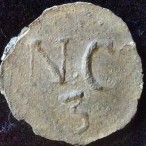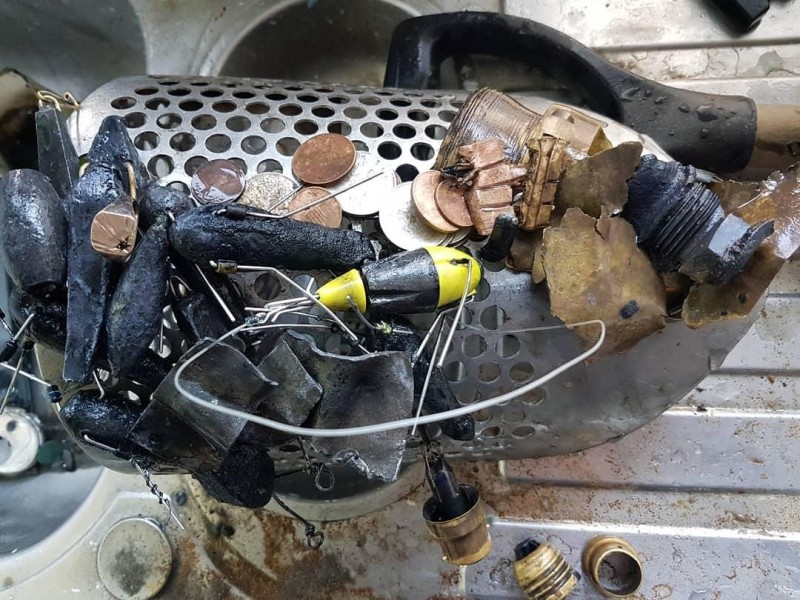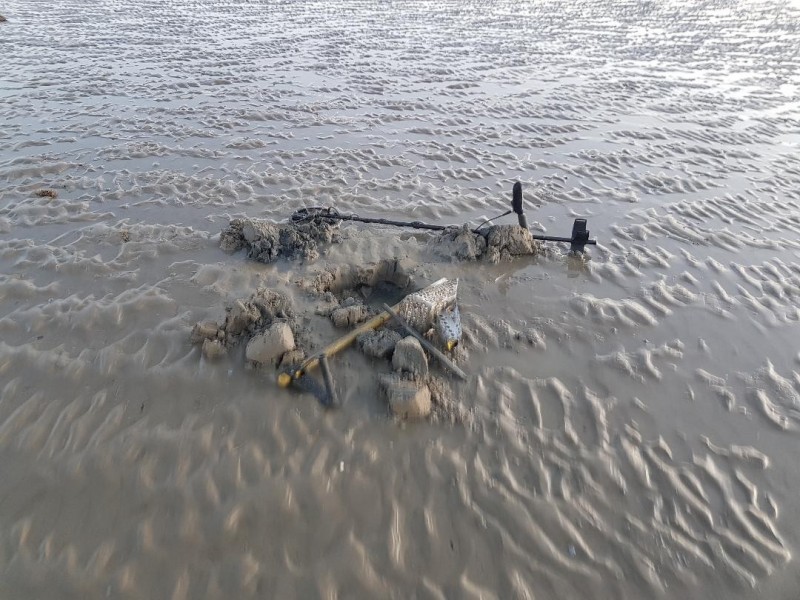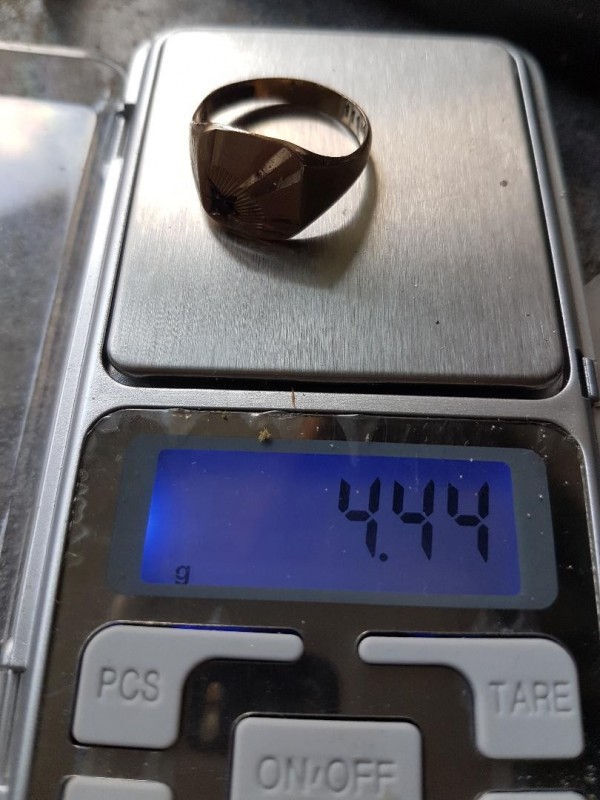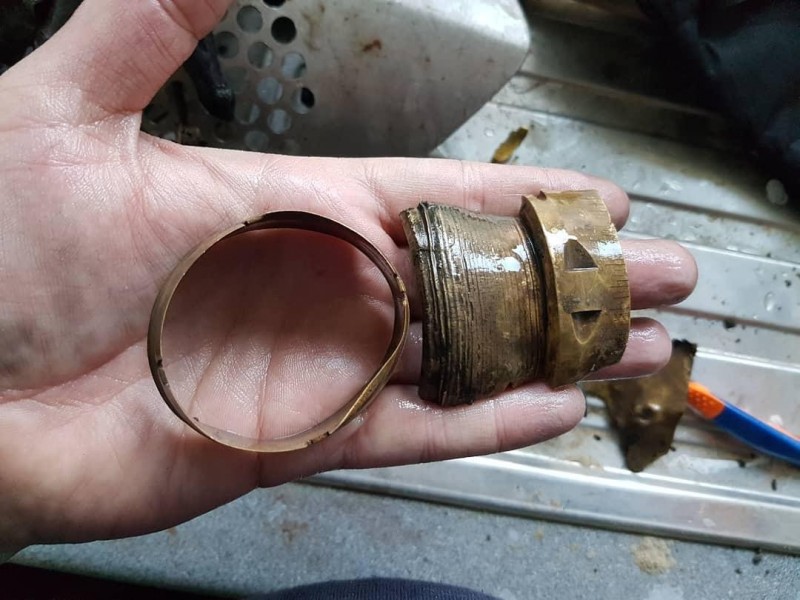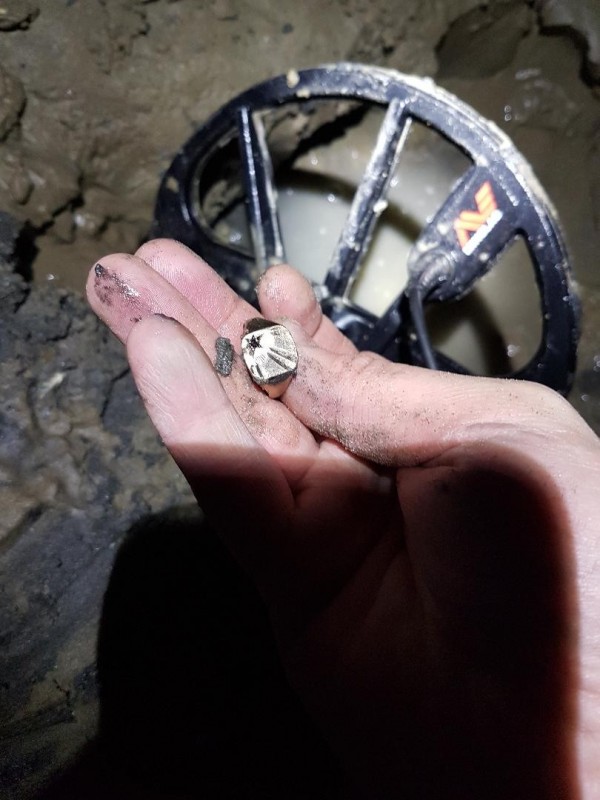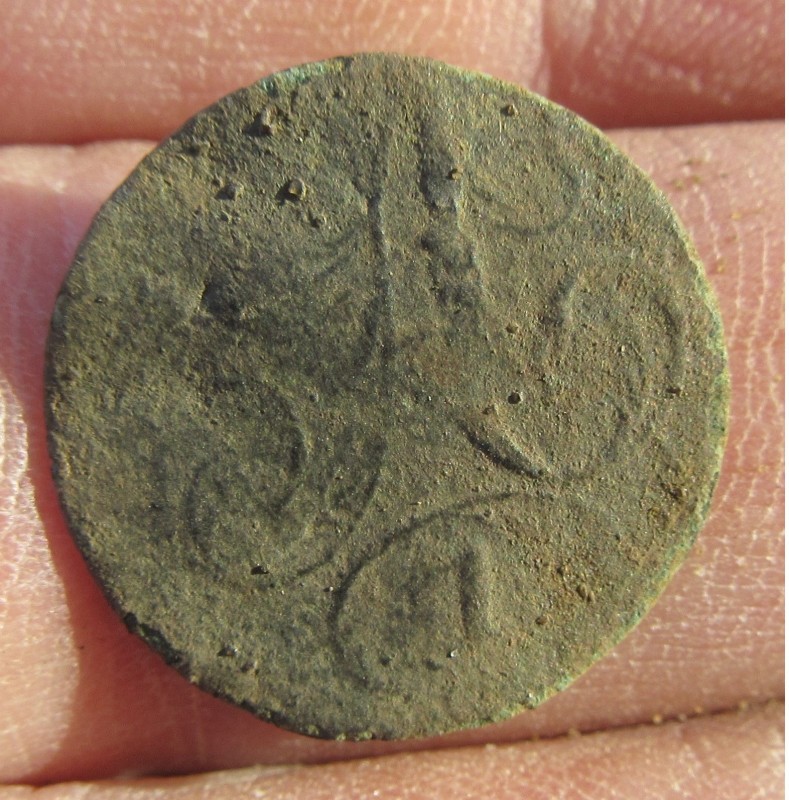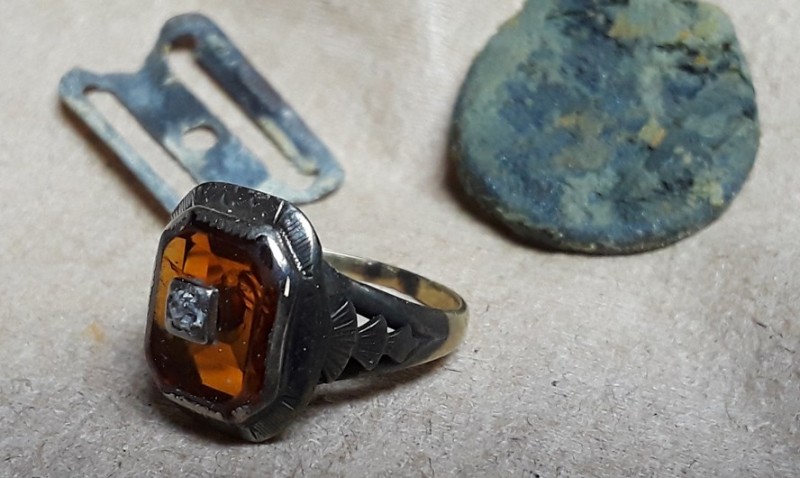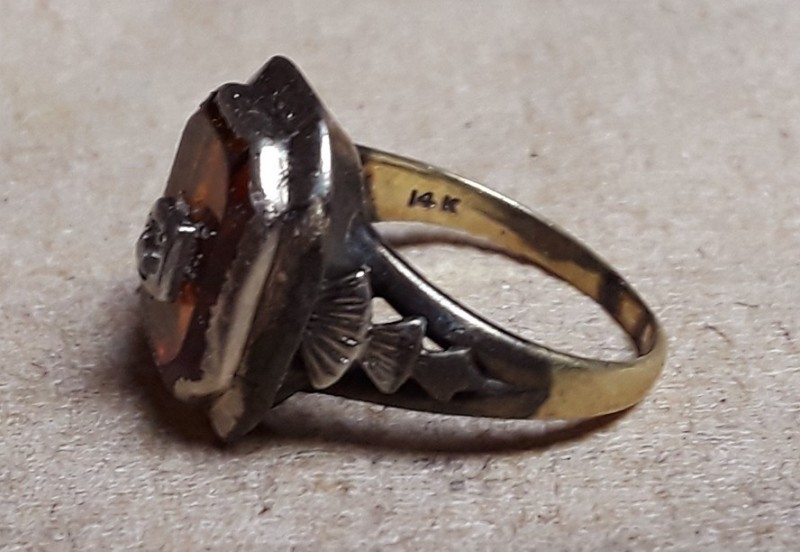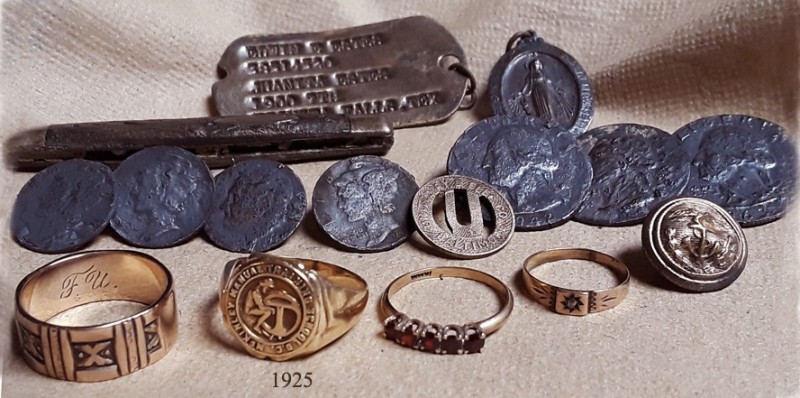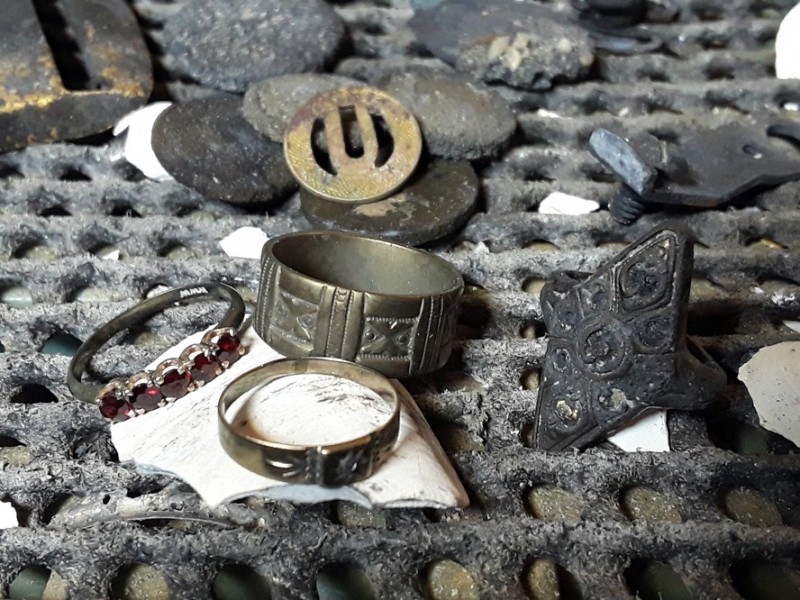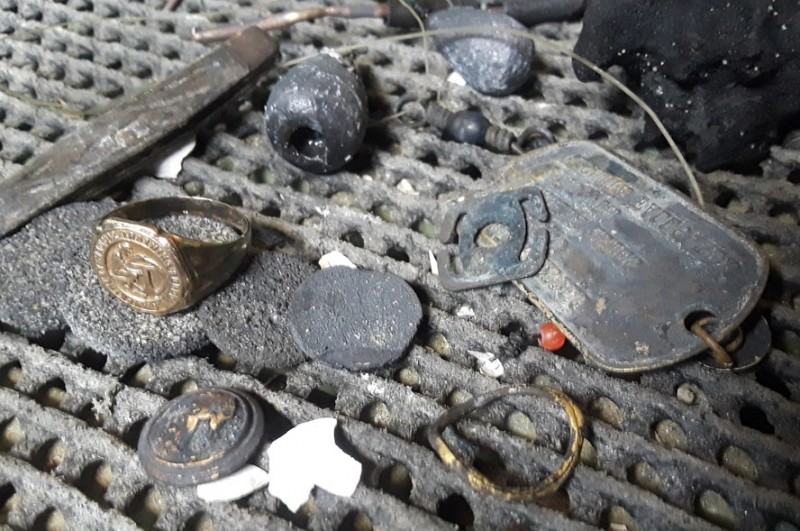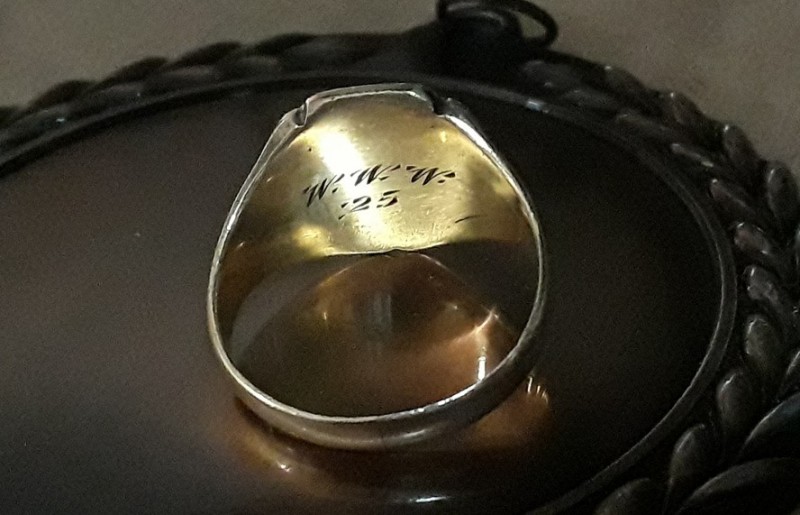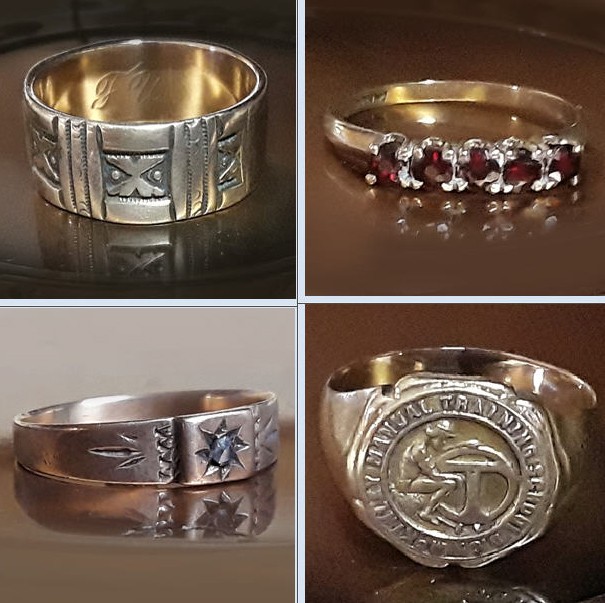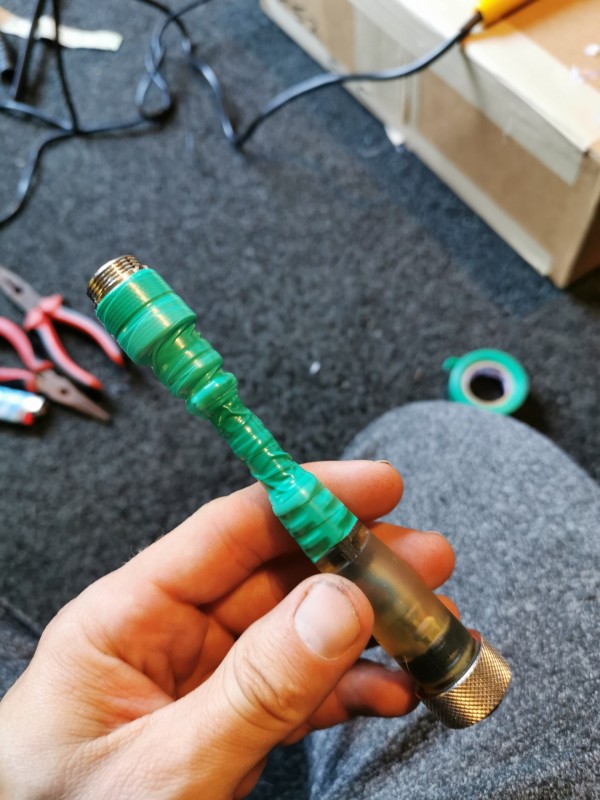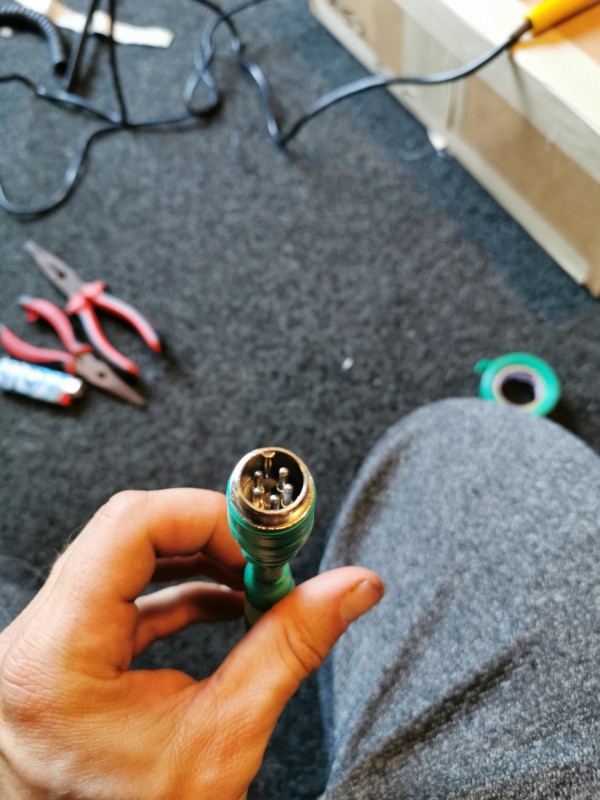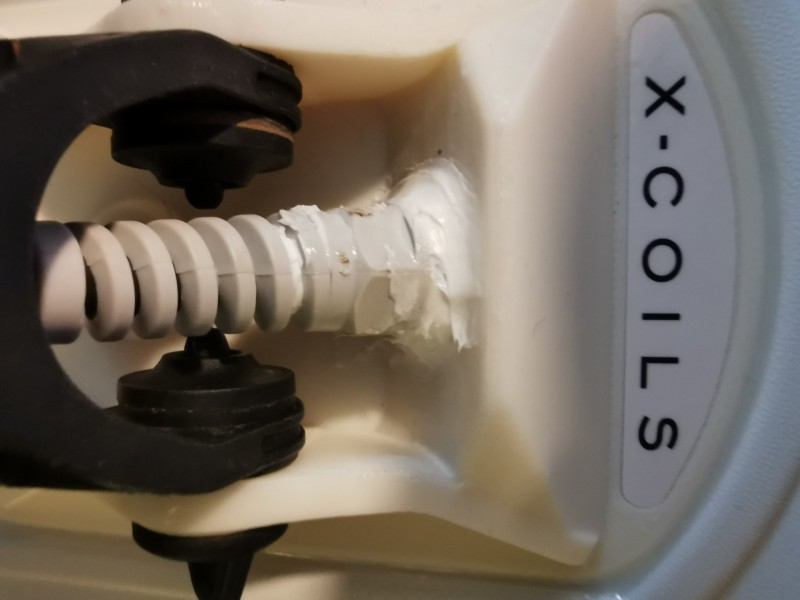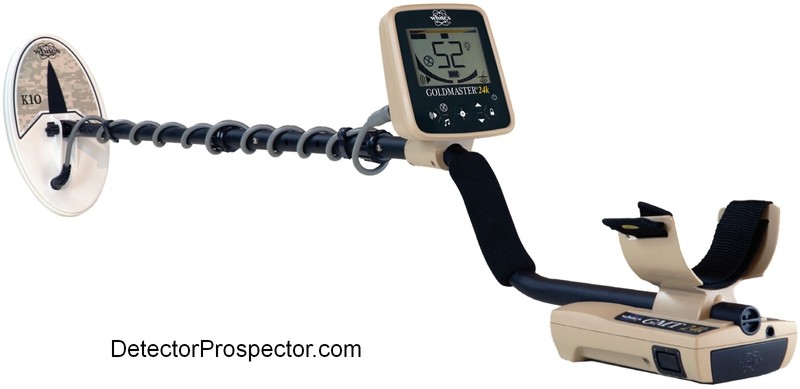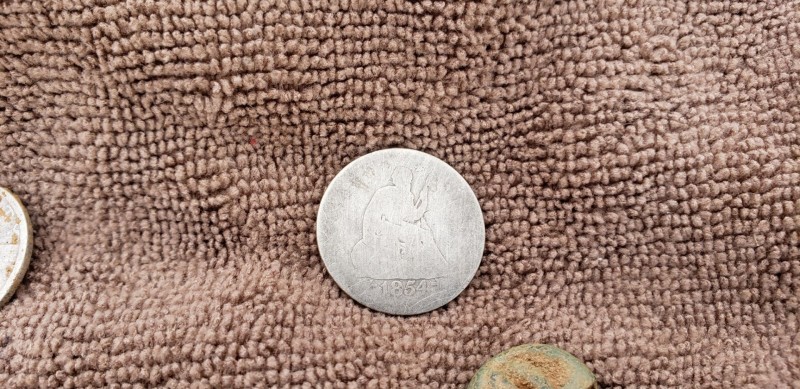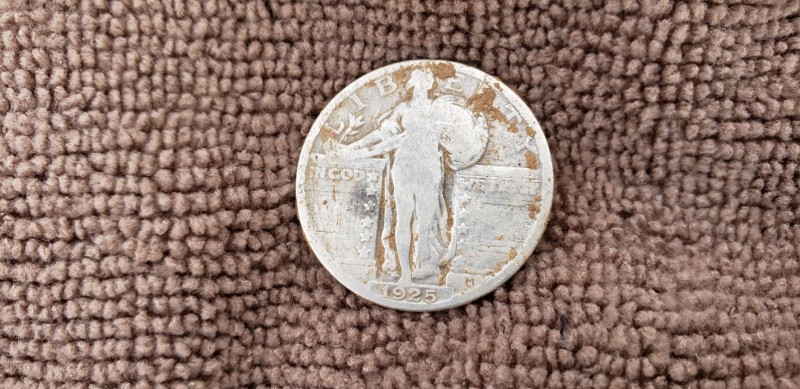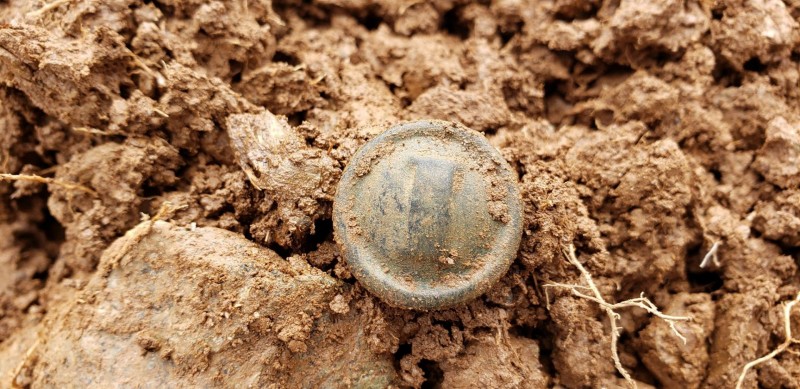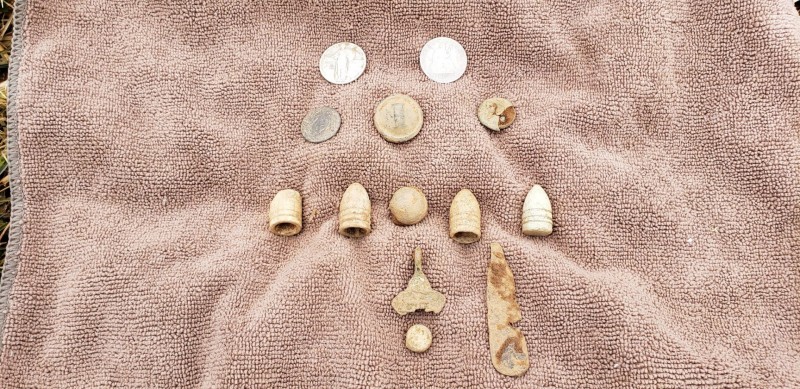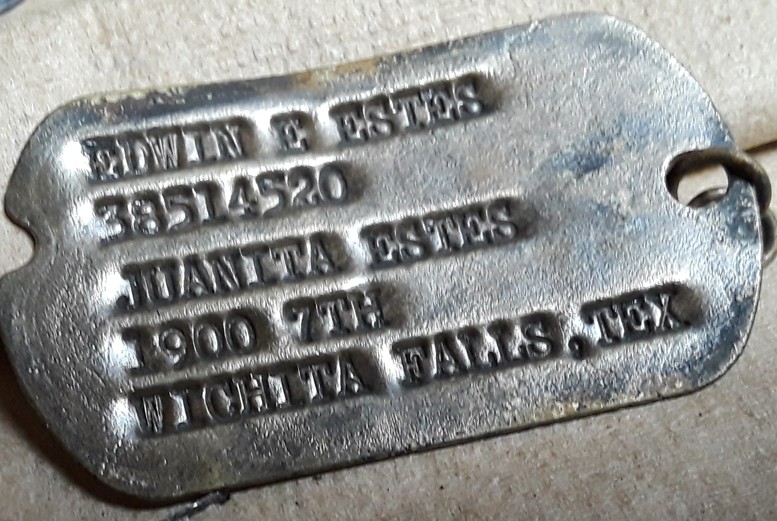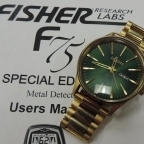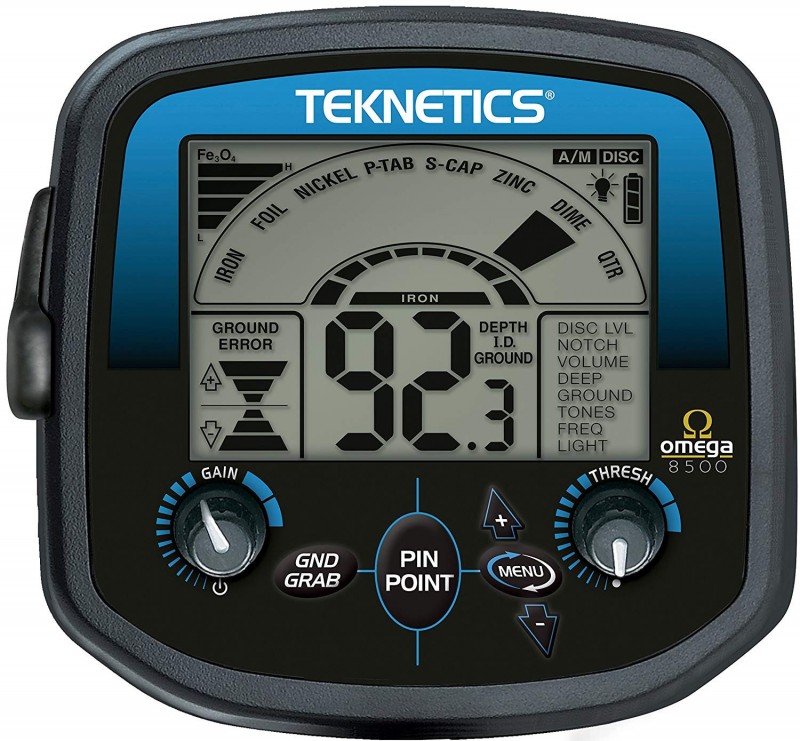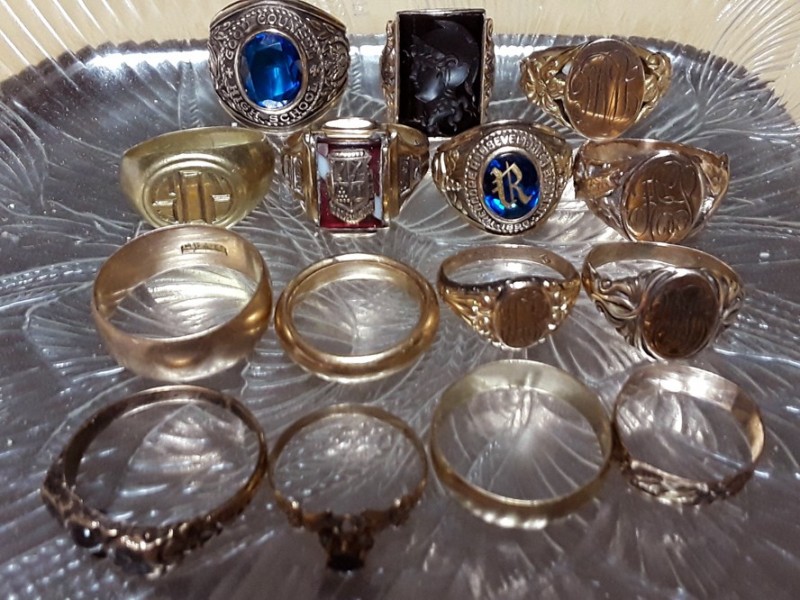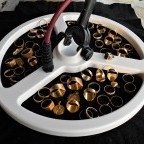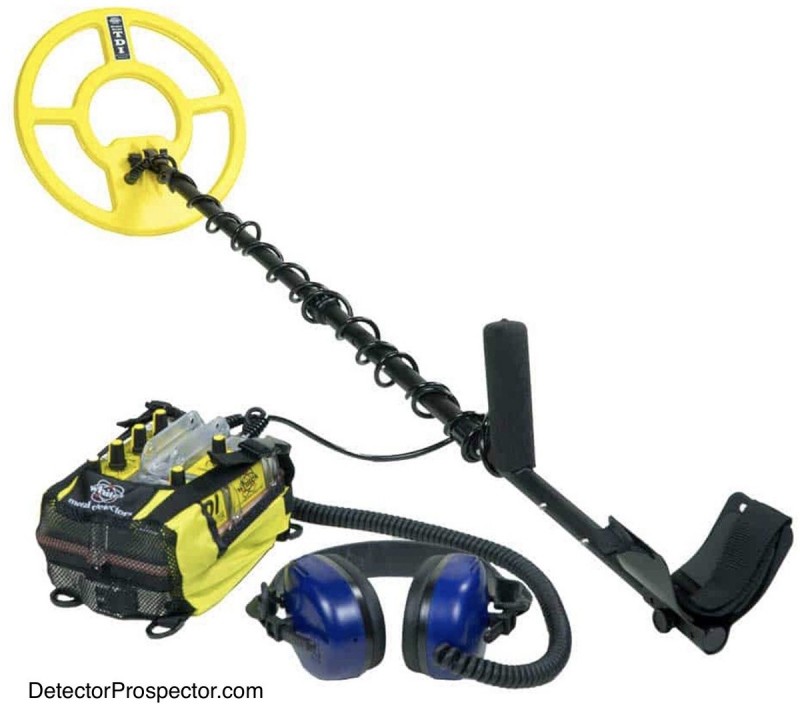Leaderboard
Popular Content
Showing content with the highest reputation on 02/12/2020 in Posts
-
7 points
-
Hello to all was was away in Vietnam for 3 weeks weeks eating and discovering the country but the crave for beach combing pushed me to schedule all my shifts straight at work then head to the coast. A Strom is battering the UK at the moment but i wasn't really interested in that i had my eyes on a beach which i think has been ignore for a while......not a really good access as the road isn't maintained and i dont have a 4x4 so i need to be careful if i dont want to leave most of my car there😅 So i took my nox which i swap for my CTX in January and headed to the spot at 5 am. Signals started straight away with big lump of brass, then i started to pick up fishing weight one after another then i hit Gold with this nice 9ct 4.45gr alas 9ct.....😪 Then few holes later my DIY unbreakable shaft broke but i brought a super dupa spade so i headed to the car and after a water refill(Was sweating despite the strong winds and low temp) i carried for another 2 hours finding the biggest anti aircraft shrapnells i ever found ,imagine been hit by that.The fishing weight are apparently 70/80s.....and the deus shaft you see on the picture of the broken shaft was actually the one i put inside to reinforce Anyway please find the result in picture,i think that that beach has much to offer will try to do another or two long session with the Nox then i will hit it with the PI.....if i succeed it will means 1 thing...my tenacity has paid off or maybe i am just getting to know the beaches better.............. Enjoy RR7 points
-
Over the weekend digs. First day(Saturday) I hit a 1890s homesite, it dates 1890s to 1930s, then next day(Sunday) went and hit one of my colonial site that I been hitting for a while.Script A, war of 1812 button, V-nickel, Sunday school pin, few flat buttons and other goodies. Script A, war of 1812 button 1908 V-nickel. Sunday School pin Few flat buttons Spoon handle Everything. Old trigger guard with some rusty iron.7 points
-
5 points
-
3 points
-
Yes, I want to see more patches come back to life as they have for JW! I've just had my initial day with it so far and there are many more to come. I've got a couple of days lined up with friends so I thought I'd make the same offer to forum friends. All days out in the field are enjoyable and finding some yellow pieces makes it more so sometimes. Mitchel3 points
-
I already have in my mind all mods to transform it in a good dive machine. Believe me, the biggest question right now for me, still remain how to use seriously a 7Ms delay in saltwater. I'm able to remove small copper plated iron cents on my TDIbh misadjusting the GB and to leave gold safe under big coins that I don't dig. (Thanks Steve!). The threshold drift at 10Ms is sometimes a pain however, even with sensitivity on 70% and in really shallow water. Hopefully a stable threshold will be the key for this machine. I know the ferrous/non ferrous target separation is at it's best due to the videos. Now I only need to test one of the first that will be here in Europe to sleep in peace😁3 points
-
As much as I love the Gold Monster, the 24K audio in both all metal VCO and discrimination two tone modes, the XGB ground balance options, the iron cancel options, the threshold tone options (a really big one for me!) and the "to die for" digital backlit display along with that super hot 6.5" coil make it a better choice for me.3 points
-
Craig, right now White's is using all of their 6 by 4s in the promotion for the GMX. The demand for the GMX has been greater than expected, thus 6 x 4's are in short supply. It might be a couple of weeks before they are available publicly. I have one of the first ones and absolutely love it! Just be patient bro. HH Jim2 points
-
I'll cautiously throw in on this since I live in S. CA and have been hunting the beaches out here since the early 1980's. I have used the TDI Beach Hunter and the Equinox 800 extensively. Cautiously since I want to preface this by saying that this is only my experience. The last time I posted a comment about this same subject, on a simple YouTube video, I got torched by PI loyalists. So here goes. From my own experience and observations, the Equinox is every bit the match for the TDI Beach Hunter. Its depth is amazing, as is its sensitivity to small gold. Let me share one experience with you that will prove my point. Last winter, at one of our beaches, a storm had come in and created a huge cut. Several of us hit it hard, a group of about six guys. 4 had Equinoxes, one had an Explorer and I decided to use my TDI Beach Hunter. While I did find a single small gold, I was so busy digging deep iron trash that my buddies were killing me in total gold finds. The reason for this is that the ground balance mode of the TDI Beach Hunter is just a gimmick and really limits your depth. You have to use it as a pure PI to get maximum depth. After several hours of digging trash I gave up and switched to my Equinox 800. My reward: a nice 14K gold chain and a 14K gold signet ring at about 15" down. Again, this is just my experience but if you have an Equinox 600, which you do, and you hunt in beach 1 with the stock coil you will get great depth and you can discriminate. The TDI Beach Hunter does get excellent depth but the "dig all the trash" aspect of it is why I generally stay away from PI's. So my advice would be to keep what you have. I have never used a Garrett Sea Hunter so I can't comment on its capabilities. Bill2 points
-
Daniel, depth is not a problem believe me... You only need to fine tune the machine to obtain a stable threshold with lowest Delay and 70/80% sensitivity. The ground balance can change the sound of objects between low and high conductors. Try a 10 Euro cents coin and slowly turn down the GB to 4/5. At a certain point it will sound like too high (low tone)..Anything under that will be little rusty iron, stainless steel bits and rings, bottlecaps,gold rings and damned 1,2 and 5 Eurocents. There's a way to remove it...but really risky.(You can miss big wedding bands.). All these settings are ONLY available IF and WHERE the water is not that salty and the bottom not that mineralized. Keep in mind, for a real ground balance, the same principle will happen turning up to 7 the GB. So other more conductive coins will be included as lower conductors. The low/hi switch is been removed from the original SL box and on the TDI/BH works this way and only with GB on.2 points
-
So I couldn't resist having a crack at my own adapter soon as my x-coil turned up today. I was pooping my undies on the enitial turn on but all in all wasn't to bad to do it you take your time I started with number 3 blue wire at bottom first as hardest to get to to solder then worked my way up to 2 and 1 the 4 and 5 spent a good 20 mins thoroughly checking for any shorts or anything when I was happy I hot glued all wires and invetween stopping them from being able to move or that in future then heat shrink followed by lots isolation tape I then put the female plug back on the std 14 and works like charm I also waterproofed the xcoil by adding marine silicone in and around the plug and a thin layer along the joining lip were skid plate goes all and all thought for a first attempt wasn't to bad and I didn't make it go boom so that a bonus2 points
-
2 points
-
Ok, I have a working 15x10 X-Coil in Southern California. I'm willing to meet up with someone within a 3 hour drive of Santa Monica (Bakersfield, Arizona border to Yuma) and you can try it on my Z (preferred) or your Z (at your own risk) and see how it performs. We can meet at a place of your choosing (if you want to know how it performs in a specific spot) or we can go to one of many well known spots. I belong to several clubs and I can take a guest. We'll both be detecting and keeping what we find. (No pool and split because I don't know how to divide equally. haha) You can use the X-Coil half the detecting time and I'll use it the other half. If this sounds like a day of detecting for you let me know and we'll see if we can set up a day. Mitchel2 points
-
The two detectors are neck and neck for gold finding capability. The 48 kHz White’s 24K at $729 is lower price out of pocket, but the 45 kHz Gold Monster at $849 comes with two coils and a rechargeable battery pack. If tuned as hot as possible but for stable operation the machines have almost identical performance. It is possible to overdrive the Gold Monster sensitivity to get a slight edge over the 24K, but it comes at the price of the coils becoming unstable and knock sensitive. I like both machines a lot and when I weeded out my collection they both stayed longer than most as I had a hard time deciding which I liked best. After a year of using both I finally sold the Gold Monster and kept the 24K. Why? Ergonomics had a lot to do with it. The 24K comes with an adjustable length rod, the GM a three piece screw together rod. Yeah, you can replace it, but why should you have to? The 24K “S” rod is counterbalanced by the battery pack under the arm, and is more comfortable than the nose heavy GM. The round handle on the 24K fits my hand better than the squared off GM handle. Finally, the 24K stays put when set on the ground and does not roll over like the top heavy GM. Each of these is a small thing in practice but all together add up to a solid ergonomic win for the 24K. The biggie for me however is enhanced options and control. I won’t make a list, suffice it to say the GM was designed for simplicity and as few controls as possible. The 24K on the other hand has a full suite of tuning options including full target id capability, which the GM lacks. I’m a control freak and more than anything else that’s what tipped it for me. The 24K is more versatile. Finally, coils. The GM you have the 5” round DD and 6” x 10” DD. The 24K has the 6.5” round concentric, 6” x 10” DD, 4” x 6” DD, and very soon 8” x 14” DD. To sum up I look at the machines as being a push when it comes to gold finding capability. Give me either and I will do fine and be happy. I recommend the GM for somebody who is control adverse and won’t read manuals. It’s as near automatic as you can get, just don’t overdrive the sensitivity. The 24K offers more versatility for those who thrive on that sort of thing, and along with the ergonomics out of box and extra coil options now I believe White’s has produced an excellent offering in the 24K. In my case at least it’s the one that stayed when the others went away. White’s Goldmaster 24K Data & Reviews2 points
-
Got a coveted invite to a productive PA permission and it resulted in a rare, but awesome couple hours relic hunting in February. Weather cooperated and the ground was relatively soft and not frozen from recent rains so we snuck out for some February relic fun.Was using the ORX, and though it did not hit on its namesake gold, it pretty much nailed plenty of keeper silver, brass, and lead.First hit was a well worn, 1854 Seated Quarter - a good omen and kept my silver streak at the site alive. With the skunk out of the way early, the Seated recovery basically set the tone that everything else found would be gravy.Next hit a 1925 SLQ in decent shape. A couple minie balls later, got a plow damaged Eagle and a nice flat button with some reverse gold guilt.Finally, hit on my highlight find of the day, my first CW Confederate Infantry Block "I" uniform button in great shape! Was kind of speechless after I realized what I had dug.Cleaned up with some additional minies including a Spencer carbine (lower left in the group pic, originally thought it was a Merrill)Couldn't have asked for a more in the three hours we were there (well I could have asked for more, but that would be just plain greedy).Used the ORX exclusively with the 9" round HF coil and Gold Mode in 14 and 30 khz. It is a very capable and affordable alternative to the Deus for relic hunting and the ORX Gold mode seems to be more refined than the Gold Field on the Deus, such that it is my go to multiple, single frequency machine for relic hunting now. Enjoy the pics.1 point
-
Snow is invisible to a metal detector. You can’t ground balance to it. If you are getting a signal, it’s not the snow.1 point
-
Yes lots of shrapnel's from anti aircraft coming to bomb London and the are air base no too much dog fights remains I am afraid maybe one day I also been told there is a target pratice in the area with 100s of bullets..................but it is on that beach that I found the 13th century hammered coin so it may have more .................I asked a local detectorist and he told me there was no one in the vicinity well I found one...........but that was with a pulse. RR1 point
-
Here is how I go about deciding what to use. Since you have and Equinox and a Sea Hunter I assume you know when you want to use a VLF for discrimination and when you want to use a PI to dig it all. It sounds like you lean to the dig it all for more depth mentality that leads to using a PI. So for this discussion I am assuming you have decided to use a PI. The question then is whether you need a ground balancing PI or not, which is why I asked about your beach conditions. I have not used the Sea Hunter but have a lot of experience with the White's Surf PI, which is similar. The Surf PI and Sea Hunter do not ground balance. The TDI has a ground balance option, so that is the difference we are exploring. In general with a ground balancing PI you will get the best depth with the ground balance off. Most PI detectors for saltwater detecting like the Sea Hunter therefore have no ground balance. There are conditions you will encounter however where this presents problems. First, in heavy black sand you will find that if you raise and lower the coil off the bottom the machine will signal due to the mineralization. This is a particular problem in heavy waves or when working a very uneven bottom. If you can keep the coil at a perfect distance over the bottom it is no problem as the autotune will smooth the signal, but if you raise the coil off the bottom the autotune can't keep up, so you get a false signal. In heavy waves where you can't keep steady footing raising the coil causes these false signals. If the bottom has lots of troughs and depressions, passing over these areas creates a false signal. The only way to deal with this if you have a Surf PI or Sea Hunter is to detune the detector until the false signals from lifting the coil off the bottom go away. But now you lose depth. Or you can leave the settings more for depth and try and sort the false signals out mentally, but this is very tiring. You can also run into hot rocks, typically basalt or rhyolite rocks embedded in less mineralized beach material. These will give a nice gold ring signal. Again, with a Surf Pi or Sea Hunter, you either detune the machine until they go away, giving up depth, or try and sort them by ear. In either of these situations a ground balancing detector allows you to eliminate the false signals I have described while retaining more depth than would be sacrificed by detuning the detector. The ground balance is basically just a ground notch setting that let's you eliminate troublesome ground signals. Gold rings that read close to the ground balance setting lose some depth. It also creates two tones, one for objects above the ground balance setting and another tone for those below the ground balance setting. Generally on the TDI if you ignore the low tone you will pass on most high conductive coins, large ferrous junk, and possibly very large or exceptionally high purity rings. Digging the high tone only gets the vast majority of rings, aluminum, nickels, and zinc pennies plus small ferrous trash. The dividing point is around zinc penny but it depends on the ground balance setting. See this thread for more details. So if you have having problems with false signals from heavy beach mineralization and hot rocks a TDI may be your solution. If not, you probably won't see much benefit, unless you think you understand and can apply the weird discrimination properties for some advantage. That's just my take on it. I'm perfectly content to use a Surf PI and dig everything in a lower cost more waterproof package than a TDI. Unless I run into conditions like I describe above, which for me were common in Hawaii. Than a ground balancing PI like the TDI can be a good alternative.1 point
-
Let me add that from a beach hunting perspective, there is not much, if anything, to be gained performance wise in going to the 800, so I agree with Bill that the Equinox 600 should be able to get it done depth wise if you decide to stick with the Equinox. No need to upgrade to the 800 unless you also want a more diverse and tweakable dirt machine (which doesn't appear to be an objective for you). Can't speak to the two other PI's in question as far as beach hunting is concerned. I have recovered nickels at 15+ inches in wet salt sand. My gold recoveries have been shallower, but from a target property similarity standpoint, if those nickels were gold rings, they would have been similarly detectable at depth.1 point
-
The leaks reminds me the time I sprung a leak in my waders. My crotch was completely soaked and when I hit a local convenience store and bought some snacks with some soggy cash I pulled out of my pocket. The gal behind the counter gave me the nastiest look and took cash with the tips of her fingers in disgust.1 point
-
Your beaches/treasure holes give up an incredible amount of unusual and unending array of beautiful and unique pieces. You are the right man in the right spot. Do you ever cash in? GaryC/Oregon Coast1 point
-
Handsome ring Joe. Good luck with the dry suit repair. Warm and dry is good, especially this time of year. Rich1 point
-
I’ve never detected Southern California beaches. In general west coast beaches are full of black sand magnetics derived from the coastal mountain ranges, and so a good place for the TDI. The other factor is trash levels and your desire for digging trash. In general places with lots of ferrous rusted stuff are a pain. PI detectors love ferrous stuff. Think hair pins and wire tie wraps.1 point
-
1 point
-
What region are you in? The TDI as a ground balancing pulse induction detector shines in mineralized beach conditions. Volcanic islands for instance. Not so much on coral derived white sand beaches.1 point
-
As a separate item? I don’t know. No mention of it on White’s website. Obviously they are making them since they come with the GMX so maybe all it takes is a phone call to the factory. Which I have not done.1 point
-
Same as i use. Met a guy once that cut his down to 4 rake prongs/barbs. I used it and it was a lot easier to use. Unless your the hulk its bloody hard work scraping dirt back with that much surface area. (maybe im just week as pi$$) I do like your magnet idea, i hadnt thought about that.1 point
-
1 point
-
Welcome to the forum, Anthony. This is great place for discussing everything related to detecting and for sharing experiences and ask questions. You will find all skill sets and backgrounds here from around the world, from beginners, coin hunters, adventurers, all the way up to professional detectorists who can tell you everything about techniques and machine that are out there. Many of us have found good gold over the years and decades and we all share the passion of prospecting and being out in nature. The Mojave desert is a fantastic place to hunt and it has many known and less known gold areas where you can still find decent nuggets. However, you need to be patient. It took me close to a year to find my first tiny little gold nugget after I bought my very first detector (GB2) many years back. So, be prepared to deal with a lot of frustration at the beginning. Most of the times, we all dig trash in every form and shape imaginable including nails, bullets, casings, wires, tin pieces and thousands of other things that are metal. However, sometimes you also find pieces of value or of historical interest, like coins or spear tips, just to name a few. My single most important advice (other than being extremely patient) is to really learn the inside out of your machine and familiarize yourself with all the settings. Every small piece of trash that you find is a sign that you can find small metal items and this should encourage you. When you have a target, play with the settings before digging it up and learn all the different noises your machine is making. The "golden" rule is to dig every single target (which I highly recommend!), but sometimes the way the detector sounds can give you some clues, especially regarding hotrocks. Also, the GM has an iron meter that can be helpful. But don't rely on it too much as it often can fool you. There is a great youtube video that my good friend Bill Southern put up where he explains everything there is to know about the gold monster: https://www.youtube.com/watch?v=_OJW9HMvQ48&t=658s He also has a great channel that I can highly recommend. Making research is a key component, I use Minecache and USGS geological maps (both in Google Earth) as my main research tools, but there are many other research tools available include books that describe placer gold districts in your area. It is a mistake to just go out in the desert and start detecting (although sometimes you can be lucky). Rather, find out where gold has been found, what deposits there are, when it was found and why, was it lode or placer, what are the associated rocks and minerals that come with it, are there tertiary channels, etc. Alot of these research techniques are described in good prospecting books, I can recommend you some if you like. Good luck and enjoy your machine and your new hobby. I warn you though: once you find your first nugget you will forever be hooked on finding gold . You will start spending ridiculous amounts of money on fancy gold detectors and equipment, you will sit over maps day and night to plan your new trips, you will likely alienate yourself from your family who will fear for your mental sanity, and you will be obsessed for the rest of your life by the magic that gold has. Be warned, you can still go back now! :)1 point
-
Thanks for the welcome! I picked up a ML GM1000 as I am just starting out, and am most interested in gold and meteorites out here in the desert where I live. Haven’t had much time yet to use it properly enough though, as always! I did manage a few hours to visit a couple gold prospects in my area, and found mostly bird shot and iron flakes - probably from the picks and other tools being used to break up some quartz veins I found nearby. No gold though... as the prospects were shallow, I guess they played out quickly (they were listed on the BLM mine register). My next real trip I plan to go on is to check out the Rand Mountains near Randsburg in the NW Mojave- getting out to this popular gold hunting site will be a successful day, and a better one if I even get some tiny flakes of color!1 point
-
Kac Yes I did get it back within a week. I do believe Dilek has something to do with it being it came back to me on two day mail. I do believe so got a new detector back . Because of rain and being cold I’ve had just one opportunity to get out detecting. I want to get out again before I write a show and tell. I will say the first time out was nothing but great. People talk about other detectors having a rock solid ID and that’s the same I see in the Simplex. Later on this . Chuck1 point
-
1 point
-
So true Phrunt. Wise words from one so young! (Younger than me anyway) I came out of the "closet" ..... as being "selfish" is counter-productive to the advancement of a detector I currently use 95% of the time. I am enjoying life without feeling guilty. It takes many $$$$ to study physics, engineering etc......then to put that knowledge and "out of the box" thinking into patenting that technology, buy components, pre market test etc etc.......all to produce a detector for end users to indulge in their hobby. In the past I used a Sovereign GT which was a brilliant beach machine but the years have rolled by and despite it still being a good unit it was heavy, and the market does not stay stagnant, which benefits us. I have little free time so try and make the most of it. Yeeup......I can take as good as I give, but I will always respect others. Learning and sharing is never ending....n'est pas?1 point
-
Hi Carolina, I was the "tester" for the NZ coil, which performs exceptionaly well to the point where I use my Tarsacci 95% of the time...... shared between our NZ west coast black sand beaches, east coast "normal" sand beaches, mud, dirt and water. Yes, I can go into overload on the very very black iron sand, but by running TH0 and Sens 9, tracking.....sometimes Blk sand setting I get results. It just means in places I have to raise the coil a bit higher than normal. Balancing of GB and salt imperative, as is the balancing of other settings. The Tesoro Sand Shark I used never got the same depth, nor did the Sea Hunter Mk2. The GPX5000 just couldnt cope in the same spot as the Tarsacci on the black titanomagnetic iron sand.1 point
-
A stunning result, congratulations, good for you!!! Sounds like you are doing incredibly well with what you have, no doubt about that. A great location and a great hunter will do well with many different detector options. YOU found the jewelry, not your metal detector.1 point
-
search lesson Last week a storm enters that destroyed the coasts, heights of waves never seen, as soon as I calm down prepare my equipment and enter the water, my old and faithful cz with me, I reached the point where by density the metals come together and began their spectacle , 53 rings, 4 chains with medals and 3 bracelets, plus a pair of earrings, total 483 gr in 8 hours of diving at 2.4 meters deep, after putting everything together and taking the photos of rigor, I understood the message "enjoy what you have and what will come" I have already passed the 4 kilos in 3 years detection, made me question if really wanted to change it? Nostalgia takes hold of me and I think of all that he has given me and I have only changed my helmets a couple of times !!! It is like part of my family, I treat it like a Japanese Catalan, I use it clean and I keep it, it goes without saying that it is worth its weight in gold1 point
-
You are completely right Jim! At the time I said that it was from a totally different perspective. In that case I was discussing the reality of target depletion. I was ruminating on the idea of a place like Ganes Creek that was full of ferrous trash and gold nuggets. In the early days there was so much gold that you could use a VLF, skip most of the trash, and get most of the gold. As time passed, all the gold that could get picked with VLFs faded away, and I was forced to go to a PI to “light things back up”. So in that circumstance it made perfect sense to use a VLF first, then go to a PI when I was forced to. On a beach I go the other way. I always use a PI first, and only go to a VLF if the trash levels are too high for me. Yet truthfully there is not a lot of difference between the two situations. So why the opposite thought pattern at work here? I think it is because on a beach I find the digging to be easy and I rarely have run into so much trash that I did not want to use the PI. I also have beach detected mainly on west coast/Hawaii, where a PI has a big edge, and so again I tend to avoid a VLF. Nugget detecting I have used many detectors, but an average machine might be the GPX 5000 with an 18” mono coil. I still love that combo. I am digging much deeper holes, and often in some pretty hard ground. So if the gold pickings are easy I would tend to grab a VLF first, especially back in the old days. The truth is in the world of nugget hunters I was probably in the minority even then. These days I am a PI/GPZ first kind of guy in most circumstances, but still more willing to use a VLF than a lot of hunters I know. Long story short you caught me in an enlightening contradiction that I can only explain by saying from my perspective it is a beach versus nugget detecting thing. For a beach I definitely go PI first and VLF when forced to. And if I look at even my nugget detecting these days that tends to be the case. But if I was going to hit a new area in Alaska scouting tailing piles I have never seen before, I might very well go in first with a Equinox and 15” coil. I would be looking for easy pickings while avoiding the inevitable deep junk. If any area did prove to have gold, I would then bring in the big guns and hit that area hard. For most places in the Lower 48 however I am finding target depletion to be so serious that I have to not only use a PI, but the most powerful machine possible, a GPZ 7000, if I really want to stay in the game. I use a VLF when I just want to find gold, which means the plentiful tiny bits I can find anywhere there is gold. But that is more for fun than real nugget detecting, where the weight does matter. Thanks for pointing that out.... got me to thinking! 🙂1 point
-
I’ve always imagined ground balance and discrimination as “necessary evils”. In other words, if I don’t have to use them, I do not. Both are electronic filters, and their use can cause lost depth and lost targets. The TDI is the best example of ground balance off giving best performance in mild ground, but there are others, like the little known ability to shut ground balance off on the GPX 5000. The thing is, if you use no ground balance, you will run into issues where increasing ground mineralization and especially hot rocks impede depth and create false signals to the point where you are better off engaging the ground balance to get back stable performance. I have found it is the hot rocks especially that are the issue. I can run a PI like a Surfmaster PI or TDI with ground balance off in pretty bad ground as long as the mineralization is even, spread out, homogenous. But toss some hot rocks in mild sand, and the false signals can get overwhelming. Same with discrimination. Digging everything is the only way not to miss good targets, especially the vast numbers of good targets masked by trash. If you don’t dig that trash target off first, that masked target at 4” stays there. It’s not all about depth; there are plenty of good shallow targets in parks masked by trash. But most people hit a wall digging trash. We all usually have time constraints, and digging everything can be counterproductive when all you have is two hours. So I turn on the disc and do the best I can. Therefore my mottos. Use a PI when you can, and a VLF when you have to. Leave ground balance off when you can, but turn it on when you have to. Leave discrimination off, but turn it on when you have to. Each of us has different thresholds for when we are forced to switch methods, and no one methodology can be said to be right or wrong as it just depends on circumstances and personal taste. The main goal is to have fun I think, and so do what it takes to make your detecting fun.1 point
-
Hi from OZ, have used Lunk's settings found gold, did a lesson with JP, used JP's conservative settings found gold. Last season run almost silent threshold max sense finding gold. Next up coming season going to switch from semi auto ground balance and try manual ground balance. Amazing machine, also going to try the SP01. Cheers1 point
-
1 point
-
Wow Joe, An impressive group of finds for the month. This time of year, you're certainly wearing the dry suit when on the jet ski - Have you thought about adding a CAPE to your outfit.? 😁 Something with your Pirate theme would look good. Best of luck for February - Rich -1 point
-
Not a lot of targets for three hours.....First Gold a hematite Intaglio Roman Soldier Ring, I believe this one is dated late 1800's to early 1900's. Second Gold ring a nice 14k monogram signetring early 1900's. 12.5 grams. Water is a chilly 41, air temp 46..with N winds at 23 mph. Had the best January I've ever had with 15 gold rings.1 point
-
Had the great pleasure to chat with Jerry *** aka tinfoil. For those who might not know this guy, back in the day, 20+ years ago he was one of the treasure hunters who wrote a lot on finding gold. He wanted me to mention that he and Pat are doing good. That he doesn't get to hunt anymore but remembers posting many years ago. He says hi to Steve too.1 point
-
The reality of naturally occurring gold nuggets is that the smaller nuggets are more common than the larger nuggets. The larger nuggets are also easier to detect. Unlike jewelry, natural gold except in active placers does not replenish. That means that in order to sell metal detectors the ability to find the small gold that is left is becoming ever more critical. However, if you are prospecting for an actual income, either full-time or more often part-time, as is true for small numbers of people in Australia and the U. S. and in far larger numbers in the third world, there is the reality of diminishing returns. I have run my prospecting as a business licensed for profit operation since 1979, and turned a profit in nearly all those years. I have only shown a loss a few times, typically when making large equipment investments in a single year. In most years I have all my equipment and costs are merely food, travel, etc. Since I work for myself there is no labor expense per se. Yet the hours do matter to me. I am only willing to devote so much time to prospecting and only if it makes a reasonable return or at least breaks even. My cut off point has declined over the years as the price of gold has gone up, and was last set at an average of 1/2 ounce per week or about 2 grams a day, figuring at least 50 hours of detecting in the week. To make this happen I need to be seeing at least half gram and 1 gram nuggets (or larger) turning up now and then. To make it on sub-grain gold I would have to be parked all day in one place using the detector to find tiny bits at a fairly constant rate. I once detected nearly 100 nuggets in one day, all under a few grains, in a 10 foot area. That made my half ounce for the week. The thing is, if that is the situation a washing device like a high banker or dry washer usually makes more sense. There are places where there is a lot of small gold, and rules make using anything but a detector difficult. I have no doubt in Africa some people exist on just the tiny bits, but they live on nothing compared to us. When full time detecting one has to be searching for new ground constantly. There are many days with no gold. So when a few nuggets do get found, they need to be good enough to cover all those non-productive days. Hobbyists on the other hand just want to find gold, any gold. They will spend a great deal of time and money to find a few tiny nuggets. That’s who buys most detectors in the U.S. The problem for me is I am one of the older hard core more serious types. If all I want to do is find stuff for fun I’d as soon go to a nearby park or beach and look for jewelry, and be home for dinner. Real prospecting for me means weeks or months in the field at a time, and lots of work. I have found many pounds of gold nuggets over the years, so simply finding a gold nugget is no real challenge for me. I almost never come home empty handed if I go nugget detecting. However, I am finding it hard to justify the time spent to use a metal detector to find gold nuggets and am slowly shifting more to doing it for fun. Long winded explanation but the bottom line in my opinion is there is a place in the nugget hunting world for a detector that can handle alkali conditions, and that by default means small gold will be lost for reasons we have already covered. Tune out the salt, you lose the small gold anyway. But many gold nuggets do hide in alkali conditions. The other lesson there is that having a salt compensation mode would be very useful on the gold prospecting version of the Impulse.1 point
-
The Ski I use for short hopes, around 2 miles. And if I'm going into a congested area. Anchoring the boats in the congested area's kind of alarm people for some reason, the ski they hardly notice....... The boat I use for distant beach's. I have 4 ramps I can launch from in the bay, ....in area's I hunt. Some of the spots can be up the rivers and over 8 miles distance. So those I use the boat...I feel safer. Here is a jetski spot, very tight quarters..so the ski is perfect. Video from late last year.1 point
-
Very wise words Steve and people should listen, time is passing to fast enjoy the now tomorrow is another day! Recently my wife died, was with her for 37 years and time just flashed by and when you look back it seams only a few years! My motto at this moment is " Live your life in the now, and don't think of the future "1 point
-
I've been thinking about it for a while, however to reach low prices it would only be ALL METAL. No magnetic ground effect compensation. I also drew it completely. It would of course have all the settings ... delay, freq, volume, threshold etc ... a waterproof version 60 meters1 point
-
He mentions in the video a couple months for the GMX so maybe same for the coil for some inexplicable reason. NokMak makes all the U.S. manufacturers look like they are mired in a mudhole with a two wheel drive ATV.1 point
-
...is that you can chest or hip mount the control box using the included pouch. The BeachHunter TDI is already the lightest weight waterproof ground balancing pulse induction (GBPI) detector on the market at 5.2 lbs. It is also the only GBPI model that comes ready to hip or chest mount. If you chest or hip mount the control box all you are swinging is the rod and coil at about 2 lbs. Nice! Note that the coil on the BeachHunter TDI is hardwired to the control box. Use care not to bend and stress the connection point to the control box as it could lead to premature failure of the coil cable. More about White's BeachHunter TDI White's TDI BeachHunter with control box in hip mount / chest mount pouch1 point


.thumb.jpg.d71314a45f3dc82bf75ac1b96e7e9201.jpg)
